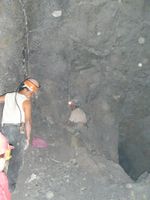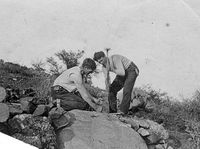Dynamite
Dynamite is a highly explosive substance used in demolition, construction, and mining. It is not used as often now, since more effective substances have been discovered and invented. Dynamite is a mixture of nitroglycerin, an absorbent substance, and sodium carbonate. Manufacturers form this mixture into large stick formations to be sold and distributed. The process of creating dynamite is both dangerous and difficult. Dynamite factories are often highly protected. Alfred Nobel, the inventor of dynamite, came upon it almost by accident. Already a successful man, he sought a more controllable explosive substance. He also wanted to find a more efficient way to demolish large structures.
Properties
A highly explosive substance is explosive because of its reaction to heat or shock. This substance quickly decomposes causing a large chemical reaction resulting in what people recognize as an explosion. There are two types of explosives: primary and secondary. Primary explosives react to heat, friction, or shock. These are very sensitive and dangerous. Secondary explosives are much less sensitive. Dynamite is one highly known primary explosive. Its three components are nitroglycerin, something to absorb the nitroglycerin like sawdust, and a minimal amount of sodium carbonate. The more absorbent used, the less primary and more secondary the dynamite becomes. The nitroglycerin inside the substance is a very explosive liquid-type substance. When dynamite is detonated, the nitroglycerin burns and causes the rest of the substance to explode. [1]
Manufacturing
Factories
Dynamite manufacturing is strictly regulated and exclusive. By fear of accidental detonation by random heat or spark, manufacturing companies are located far from electrical power sources or other buildings that may be producing sources of heat or ignition. Manufacturing buildings are also covered in some sort of bullet proof material to protect the contents. Simply put, the making of dynamite is the process of safely packaging the highly dangerous substance known as nitroglycerin. Every step to the manufacturing is checked and thoroughly examined to ensure no mistakes are made by workers or machines. The workers and manufacturers are all highly qualified with the most extensive training possible. Extreme health precautions are also required, because of the toxic chemicals workers may encounter frequently. The makings of dynamite also includes ethylene glycol dinitrate. This substance prevents the nitroglycerin from freezing and becoming more dangerous when used in cold areas. [2]
Preparation
The oily state of nitroglycerin is mixed first with a flour-like substance. This substance (which may be sawdust, wood pulp, or starch) absorbs the oil and becomes a more malleable paste. These are all well-mixed not by hand but by a mechanical mixer. An antacid is then added to this mixture in order to slightly neutralize the acidity within. During this time the manufacturer may decide how strong the dynamite may be. The term "straight dynamite" refers to the ratio of nitroglycerin to the starch it was mixed with. For example, 30% straight dynamite consists of 30% nitroglycerin and 70% starch. This dynamite may not be as strong as 40% straight dynamite. The third step in manufacturing is packaging. With the mixture already formed, the paste-like dynamite may be pressed into a paper tube of the desirable size and then sealed with paraffin. Presently, dynamite is available in both the tube formation and small cartridge forms as well. Regulations on size, however, are set to prevent extremely dangerous situations for miners or builders. Some dynamite manufacturers may also sell their product in a powder form. [2]
Uses
In present day, dynamite is not used nearly as much as it was when explosives were first popular. Many other types of chemical explosives are now being used. However, dynamite and TNT are still often used. Dynamite is more often used for imploding buildings than mining currently. Many other chemical explosives have been found less dangerous and more precise. [3]
Mining
Many mining museums have large portions of history centered around dynamite. The use of explosives was a large break through for miners and their work. Many explosives are still used in the same way that dynamite was previously. Dynamite was used to break up large rocks to make a miner's work easier. The dynamite, stuffed into small holes bored into large rocks, would implode the rocks into smaller and more easily moved pieces. Also, mining caves are easier made with the use of dynamite and explosives. Miners will bore holes into the sides of large hills or structures to create entrances so they may easier reach whatever they may be mining for. Explosives and dynamite are most often used in underground mining. [3]
Demolition and Construction
Dynamite is still used today for the demolition and implosion of buildings. Construction and demolition workers bore holes into the concrete columns of buildings in order to stuff these explosive materials inside. They will cover the building with these explosives before igniting to implode the entire structure. When ignited, the dynamite catches fire so quickly producing so much hot gas at the same time that the pressure of the gas begins to destroy the concrete around it. [4] In the past, during the 19th century, dynamite was more often used to destroy large obstacles in preparation for buildings and train tracks. Dynamite was also used to destroy large rocks and also form tunnels for trains to pass through. This was a very important resource during the industrial revolution. Dynamite was the safest of all explosive substances during the 19th century, and while many construction and train business were flourishing, many relied on dynamite to grow their companies across America. [5]
History
Alfred Nobel, the founder and inventor of the Nobel prize, also invented dynamite. Nobel was one who was highly involved in the construction of both bridges and buildings. Being an innovative engineer, he searched for a more efficient way of demolishing and deconstructing large rock-built structures. In 1860, the industrialist began experimenting heavily with nitroglycerin, which was previously discovered by an Italian chemist. Knowing nitroglycerin was highly dangerous, before even finding another form of it, Nobel invented some sort of detonating cap for the substance. In 1863 he patented his own design. Instead of heat or fire, this first detonator was ignited by shock. Alfred continued to experiment with the liquid state of nitroglycerin, soon finding in 1866 that when mixed with silica it transformed into a quite malleable solid. This paste was then molded into the dynamite stick shape that is still used today. He continued to innovate his product even more thoroughly when he invented a new detonating device prepared especially for mining. This new detonator consisted of a fuse, patented in 1867. [6]
In the 19th century, the height of the industrial revolution, dynamite was found to be a key invention. While many cities, towns, and railroads were being built, many obstacles needed to be destroyed in order for real growth to begin. Before this invention had taken place, people relied on black powder and pure nitroglycerin to create tunnels and blast trough large rocks. Black powder was not powerful enough, and nitroglycerin was known to be very dangerous and unpredictable. The invention of dynamite then led to even more innovation and efficiency in both demolition and industrial growth all over the world. Into the 20th century, the availability and easy access to dynamite and such explosives began to increase. Such availability led to the use of dynamite and TNT as murder and assassination weapons. Because of these occurrences, Alfred Nobel began to see the danger he may have released into the world. His feelings of guilt are exactly what led him to create the Nobel Prize. [7]
Video
Quarter-stick of dynamite explosion.
References
- ↑ Three Common High Explosives and Their Properties. Hubpages. Web. 30 July 2010 (Date-Published).
- ↑ 2.0 2.1 Betts, Douglas. How Dynamite is Made MadeHow. Web. 30 March 2014 (Date-Accessed).
- ↑ 3.0 3.1 Explosives infoplease. Web. 30 March 2014 (Date-Accessed).
- ↑ Harris, Tom. How Building Implosions Work HowStuffWorks. Web. 30 March 2014 (Date-Accessed).
- ↑ U.S. Construction web.bryant.edu. Web. 30 March 2014 (Date-Accessed).
- ↑ Bellis, Mary. History of Dynamite About.com. Web. 30 March 2014 (Date-Accessed).
- ↑ A Blast From The Past: The Creation of Dynamite WordPress. Web. 21 March 2011 (Date-Published).
| ||||||||||||||



